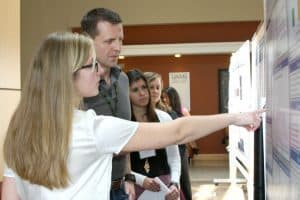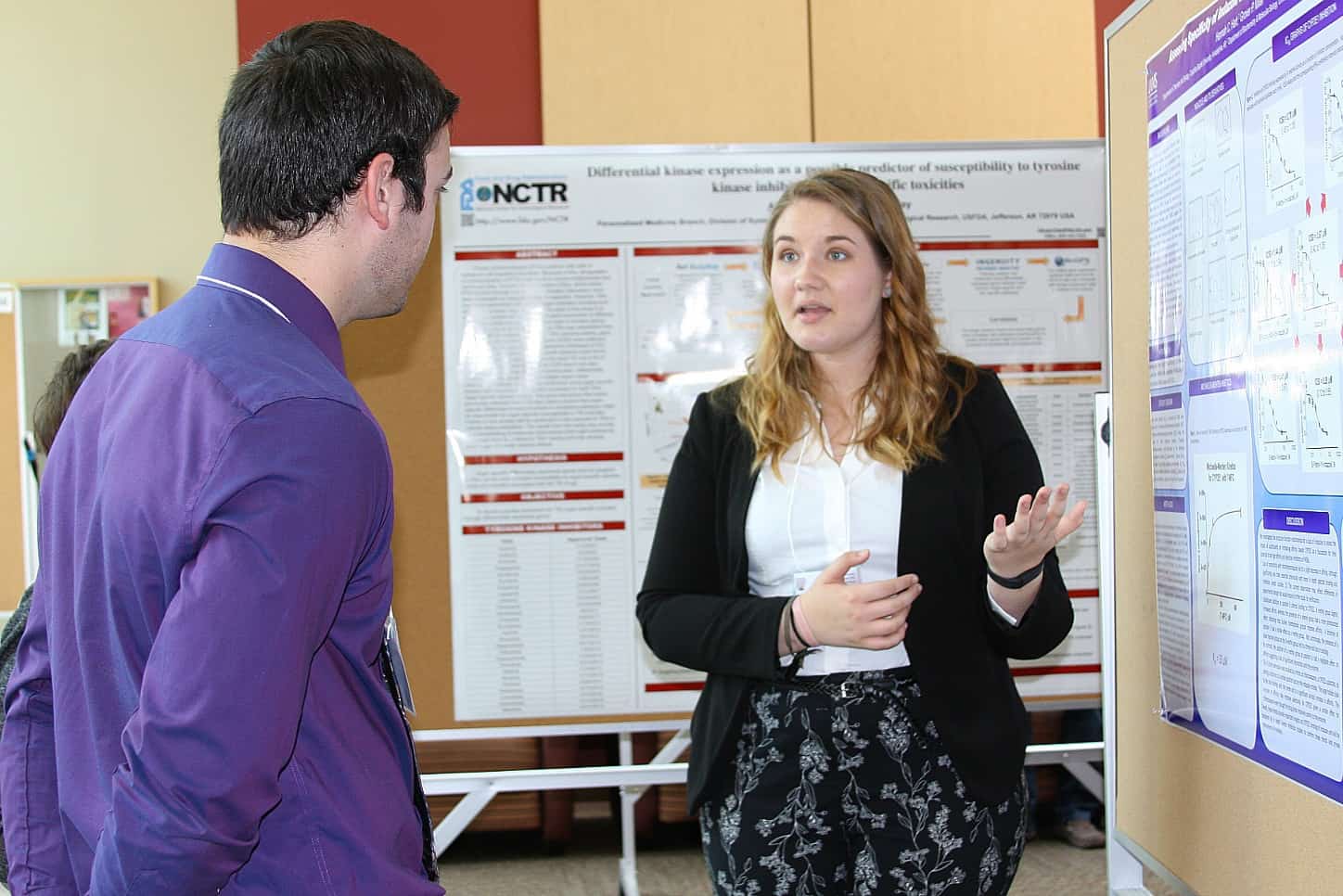Symposium Highlights Undergraduate Research from across Arkansas
| July 26, 2016 | Tomorrow’s leaders in scientific research have been working hard this summer, and the Fifth Annual Central Arkansas Undergraduate Summer Research Symposium gave them a chance to showcase their efforts while practicing their presentation skills and learning about careers in science.
On July 20, UAMS welcomed 114 undergraduate researchers, who came from 15 colleges, universities and institutions across Arkansas along with 18 colleges and universities from 14 other states. Those students presented findings from their summer research projects that were supported by individual faculty research studies and seven formerly organized undergraduate research programs at host institutions in Arkansas.
Kevin Raney, Ph.D., chair of the Department of Biochemistry and Molecular Biology in the UAMS College of Medicine and one of the event’s organizers, said the symposium serves several purposes. For one, it brings together undergraduate researchers so they can connect with each other.

University of Arkansas student Amanda Ederle, from left, explains her research to University of Arkansas for Medical Sciences biochemistry Professor Alan Tackett as students Sara Frey and Christa Jackson, both of John Brown University, look on.
“It also celebrates their accomplishments, celebrates their ability not only to go through the normal practice of an undergraduate education but, actually pursue a research project in the summer time or during the school year,” Raney said. “And so that teaches a whole new set of skills – problem-solving skills, time-usage skills. It also gives those students an opportunity to decide if they really enjoy that, and helps them make a decision in terms of their long-term career plans.”
This all-day event was hosted by the UAMS Graduate School and Department of Biochemistry and Molecular Biology, and the National Institutes of Health (NIH)-supported IDeA Networks of Biomedical Research Excellence (INBRE) program. They recruited not only undergraduate researchers but also 14 administrators and 50 faculty mentors to share and contribute to the success of the symposium.
“This event is an opportunity to highlight what these students achieve in the summer, what we achieve in Arkansas in multiple programs. It highlights the mentors that spend the time and effort, the students, the administrators – everyone who makes this possible,” said Grover P. Miller, Ph.D., associate professor of biochemistry and molecular biology in the UAMS College of Medicine. “So these investments are definitely something that will benefit us down the road and why we need to develop these programs and further expand them.”
The symposium included 93 research posters and 12 oral presentations in a variety of disciplines, including biology, chemistry, physics, engineering and computational sciences.
Southern Arkansas University student Lindsey Wood, who was participating in the symposium for the second year, said her favorite part was the time spent in the lab doing research.
“Arkansas INBRE really gave me an opportunity to research as an undergraduate that I would not have had otherwise,” Wood said.
Ouachita Baptist University student Hannah Hart said she has long been drawn to a medical career but participated in the program because she wanted to see if research might be right for her.
“I think it will definitely be on my mind as I choose where to apply, what programs to apply to, whether it’s grad school or med school or an M.D.-Ph.D. program,” Hart said. “It’ll definitely have a big impact on what I choose.”
The symposium also exposed students to opportunities in research and education at UAMS. It allowed them to build relationships with other students and potential mentors interested in similar areas of study. Organizers created a new award this year to acknowledge outstanding mentoring. The first recipient of the Mentor Award was Thomas Goodwin, Ph.D., of Hendrix College. During his career, Goodwin has mentored hundreds of undergraduate researchers, who have gone onto do great things at academic or industrial research positions locally as well as across the country.
Miller noted that participation in the symposium has been increasing since its inception five years ago, with an increase of 20 percent in undergraduates presenting research compared to last year.
“This program is still growing because there’s still so much great research occurring across the state. That’s where having support from these different programs, UAMS and institutions helps make this possible,” Miller said. “We need that continued commitment to make this work because it is making a difference. These students are the ones who apply to our graduate programs, our medical schools, our pharmacy schools. This symposium is an opportunity to reach out to them and show them what they can do.”
